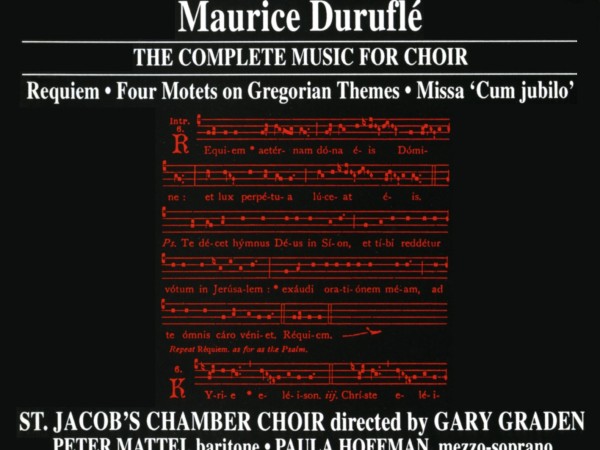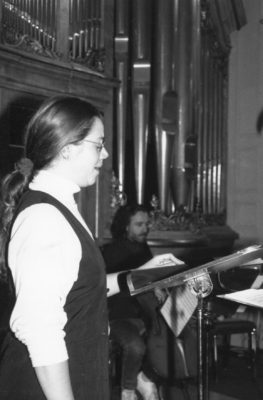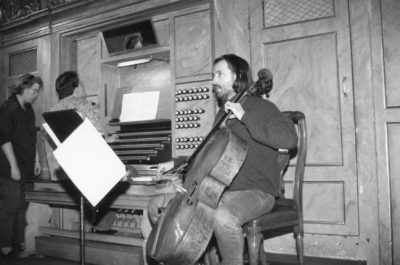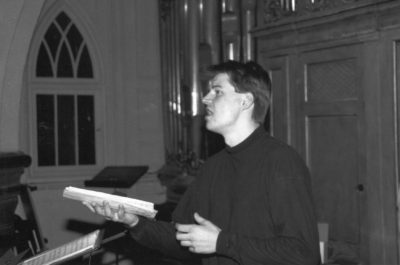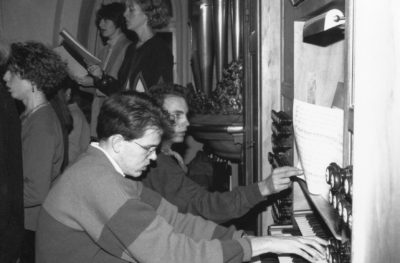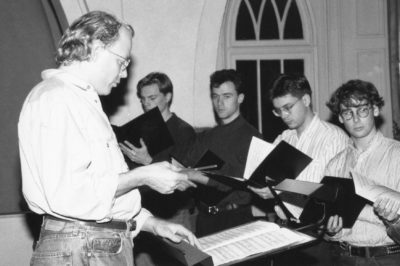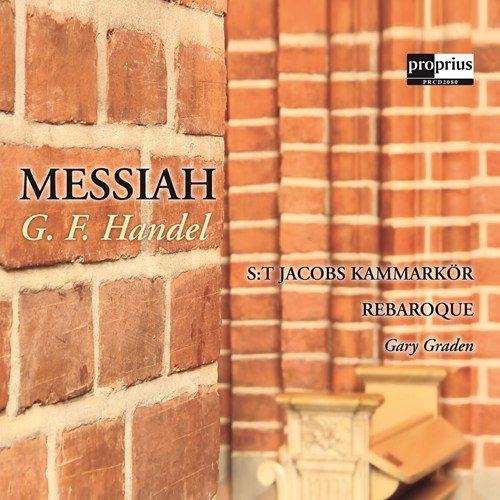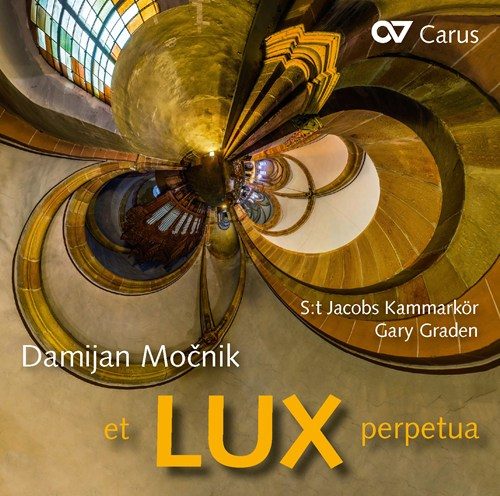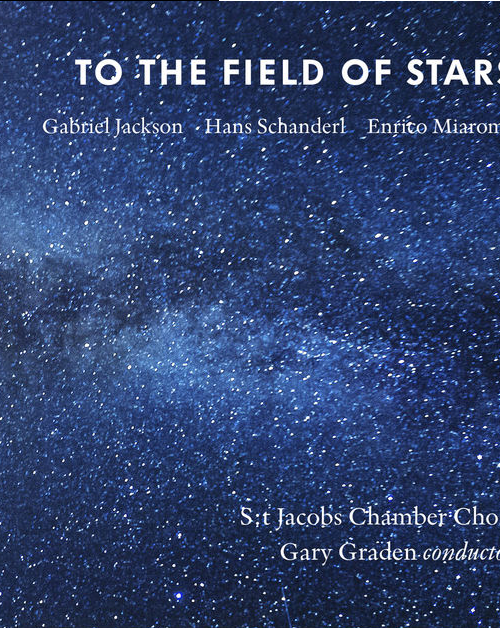single album
Maurice Duruflé, The complete music for choir
Booklet (click here)
About this CD
Release Date: 10/12/1994
Label: Bis CD-602 Spars Code: DDD
Composer: Maurice Duruflé
Performer: Paula Hoffman (Mezzo soprano), Peter Mattei (barytone), Elémér Lavotha (Cello), Mattias Wager (organ)
Conductor: Gary Graden
Orchestra/Ensemble: St. Jacob’s Chamber Choir
Number of Discs: 1
Recorded in: Stereo
Length: 1 Hours 11 Mins.
Edited By Siegbert Ernst
Engineer: Jeffrey Ginn
Producer: Robert Suff
Recorded in St. Jacobs church nov 9-12 (1-9+14-18) and dec 12 (10-13) 1992
 The recording gets the highest rate at a big comparison in Répertoire march 1998
The recording gets the highest rate at a big comparison in Répertoire march 1998
Skivan hamnar på förstaplats i en stor jämförande artikel i tidsskriften Répertoire mars 1998
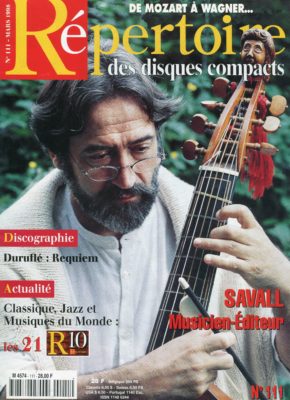
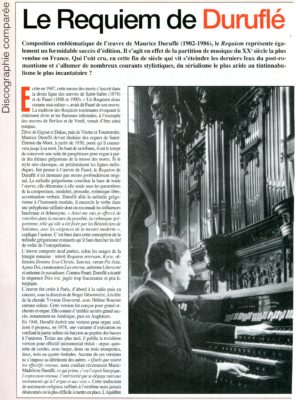
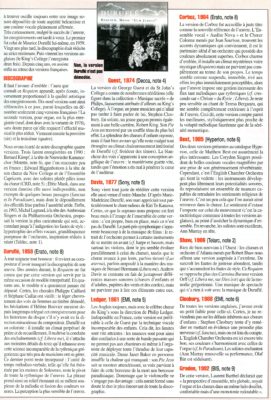
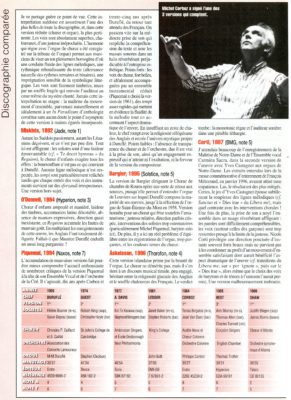
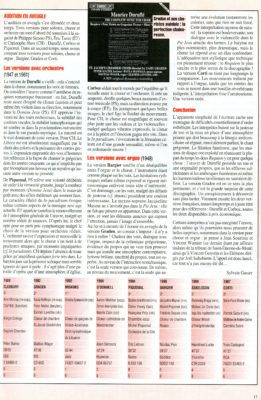
Fritt översatt till svenska
Sid 15
“Beträffande denna version förklarade Laurent Barthel att “ensembleperspektivet, mycket omfattande, dränkte orgeln och körerna i en och samma kletiga ljudbild, bekväm men fruktansvärt monoton”. Jag delar knappast denna åsikt. Denna svenska tolkning är förvisso en av de vackraste av alla inspelningar, och, i denna reducerade version (kör och orgel), den mest tillbörliga. Rösterna är absolut underbara, varma, med en träffsäkerhet som inte lämnar mer att önska. Samklangen med orgeln (kören är inspelad på orgelläktaren) tillåter musikerna att sikta en ton till fullo homogen med en flytande ledning av melodiska linjer, studsande textrytm (naturligt alternerande med två- respektive tretakt), en känslig uppfattning av den symboliska liturgin. Rösterna är finsmakat klangfulla, med en ömtålig andning som tar åhörarna till botten av sångmysteriet. Aldrig fastnar denna tolkning: behärskningen av ensemblens rörelse, som naturligt och idealiskt uppnår ett “In Paradisum” som en höjdpunkt för hela skivsamlingen. Denna version är i många hänseenden omöjlig att förbise.”
Sid 17 Sammanfattning
“…Gradens version är vad gäller detta den mest tillbörliga, och den är den stora överraskningen i denna skivsamling. En inspelning att upptäcka utan vidare dröjsmål. Sedan kommer de två franska versionerna, som har hängt med länge och har goda namn: Duruflé och Corboz, båda tillgängliga till bra pris.”
Sid 17: Versionerna med orgel
“…Allteftersom man lyssnar i blindo till Graden-versionen, tränger sig ett konstaterande på: Det finns inget mer att säga! Värme i rösterna, dialog med orgeln, respekt mot den gregorianska rytmen, klarhet i framförandet som inget vill bevisa men som ger en kontemplativ atmosfär, brännande lyrism, uppriktighet gentemot ämnet, allt är underbart. Beträffande samspelet text-musik är det den enda versionen som får godkänt. Dessutom, vad gäller tempot, är det den enda som berättigar en utveckling (särskilt färgeffekterna), utan att något blir forcerat. Denna tolkning strålar av naturlighet: sopranen är omvälvande, hennes dialog med cellon i Pie Jesu tvingar fram tårar. Barytonen är mer skrytsam, mer dramatisk, men kören svarar honom med hänförelse. Stilistiskt såväl som tekniskt är den till fullo lyckad: Det mest uppriktiga och fridfulla Requiet i hela samlingen.”
Photos from the Recording session. More Reviews further down
Paula Hoffman
Elémér Lavotha
Peter Mattei
Matthias Wager
 BBC Classical Music march 17, 2022
BBC Classical Music march 17, 2022
Gary Graden (conductor)
Paula Hoffman, Peter Mattei, St Jacob’s Chamber Choir; Mattias Wager (organ) (1983)
BIS BISCD602
Perfectionist that he was, Duruflé would surely have approved of this recording of the version for choir and organ, as it is immaculate. Every phrase has been lavished with love and attention by the Stockholm-based St Jacob’s Choir and their conductor Gary Graden, whose impeccable balance between voices, and between choir and organ, ensures that not one moment of Duruflé’s sumptuous harmonic writing goes to waste – whether in the thundering chords of the Domine Jesu Christe or the most delicate pianissimo of the In Paradisum, their consistency of tone never lapses. For a masterclass in flawlessness, look no further. But is it a little lacking in character? Possibly.
 Classic CD october 1993
Classic CD october 1993
Duruflé’s Requiem, performed here without an orchestra, allows attention to be focused on the beauty of the drama of Berlioz and Verdi is absent; the emphasis more on the hope of reconciliation, following Fauré’s pattern. Indeed, there are echoes of that Requiem in the Sanctus and Libera me.
The music is mostly ethereally serene and consolatory. Particularly memorable are the Pie Jesu with Paula Hoffman’s pure tone floating above the organ and cello, and the lovely melodies for the organ in the Agnus Dei and for the choir in Lux aeterna.
The two supporting works, both based on Gregorian melody, are equally attractive, particularly Tota pulchra est for three-part women’s choir and the Gloria of the Missa Cum jubilo for unison male choir and organ. The performances are highly polished and the young chorus and soloists sing with great refinement and control throughout. Mattias Wager’s accompaniment is concistently sensitive and finely phrased. The sound is also excellent.
Ian Lace
 Fanfare Magazine Issue 17:2 (Nov/Dec 1993
Fanfare Magazine Issue 17:2 (Nov/Dec 1993
Duruflé’s Requiem and Mass are better known on disc in their several orchestrations by the composer. The organ versions generally signify church performances and, given the cost of the full orchestration, generally best known to live audiences. But, the lack of orchestra ought not put off listeners here.
As a visit to Stockholm to review performances of works by Otto Olsson for another publication confirmed, the Swedes have quite an appetite these days for Latin church music. The Chamber Choir of St. Jacob’s Church in Stockholm is one of several in Stockholm with prominent choral and organ programs (one ought to mention the Hedvig Eleonora with its superb Gronlunds organ and virtuoso player Torvald Torén as well as the Gustav Vasa Church and its Oratorio Choir). That the St. Jacob’s singers are conducted by an American comes as somewhat of a surprise.
Even more serendipitous are the knowing and focused performances. Where the arch crescendo at the end of the Requiem’s Kyrie doesn’t quite raise the goose bumps, the enormous restraint of the quiet music and the singers’ intense control does.
Shortly after Maurice Duruflé’s death, Mme. Duruflé wrote to this critic that he appreciated bringing out the themes of the motets, especially the canon on the “Tantum ergo.“ While that particular effect could have been more pronounced, Graden evokes sensitive performances.
He builds real excitement, however, in his reading of the least performed work of Duruflé’s small choral output, the Missa “Cum jubilo.“ Like the Requiem, this score essentially embraces plainchant with the glow of French impressionist harmony. Whereas Duruflé achieves that in the Requiem with the web of four (and more) choral lines, here he limits the singers to a choir of baritones. The noble chant sounds forth unencumbered. That comment applies to the performance as well. Graden’s male singers establish an uncontested unison and, although they narrow-bore the upper registers a bit for my taste, the tight sound penetrates Duruflé’s virtuoso organ score which is played to a fault by the young and capable Mattias Wager. Overall, an excellent product from unlikely sources.
Haig Mardirosian
 Musicweb international oct 2003
Musicweb international oct 2003
It is good to have a digital ‘organ only’ version of Duruflé’s sublime Requiemin the catalogue. Whilst I am of the opinion that the ‘middle’ version (for chamber orchestra) of the three he made is probably the best, as it combines his masterly orchestral colour with the required intimacy, there is much to commend this BIS disc. You may miss the extra range and variety the orchestra brings, but you will find a wonderful delicacy and subtlety here that are captivating. The restrained, meditative quality at the heart of the work are fully realised in this recording, and where drama is called for (as in the Domine Jesu Christe, where the organist literally pulls all the stops out) you get it. Though basically modelled on the Fauré, I’ve always considered Duruflé’s Requiemto be one of the 20thCentury’s great works, a piece full of its composer’s sincerest hallmarks and one which flies in the face of any modernist gimmicks. Given the organ version is something of a rarity nowadays, this BIS disc is well worth acquiring even if you have the more standard versions. The choral contribution is first-rate, with excellent balance and intonation, and the organ is played with great flair and virtuosity by Mattias Wager. Soloists are good too, with no operatic wobble to spoil proceedings.
The unaccompanied Quatre Motetsare regular fillers for the Requiem, and gorgeous little miniatures they are too. This reading can hold its own with any (I compared it to versions by Matthew Best’s Corydon forces and James O’Donnell and his Westminster Choir, both on Hyperion) with pitch rock-steady and a good blend of ecstasy and wonderment. The ‘Cum jubilo’ Massshares many of the Requiem’s qualities, and the choir and conductor here follow the beautifully flowing, plainsong-inspired lines with an almost improvisatory abandon that is both thrilling and subtly atmospheric.
The recording tames the resonant acoustic well, though microphones sound as if they have been quite closely placed. The organ is very well caught. Lovers of church and choral music will no doubt have their favourite versions of this music, but this excellent BIS reissue will sit alongside them very nicely.
Tony Haywood
Read more: http://www.musicweb-international.com/classrev/2003/Oct03/Durufle_requiem.htm#ixzz47X5NoZos
 Organists’ Review nov 1993
Organists’ Review nov 1993
There are few performances of the organ-only version of the Requiem; the King’s/Baker/Butt/Ledger is perhaps the best-known. I have to say that this new recording not only gives it a run for its money, it surpasses it in many places – balance, ensemble with organ, appropriatness in tone on top two lines, In sheer drama it falls somewhat behind. I am immensly impressed with this young choir. Superbly drilled, aged 20 and 30, vocally agile and of beautiful tone (the ladies outstandingly so,’ particularly the altos), it is an utter joy to listen to.
Following memorable performances of the Quatre motets, the little-recorded men’s voices Missa “Cum jubilo” is given a sonorous reading, though without quite the vibrant passion that a George Guest or Donald Hunt would bring to it. Emphasising the spirituality of this music is a clear aim, as is the effort to produce a supremely beautiful sound. Mattias Wager produces 100% idiomatic sound from the St Jacob’s organ, and copes flawlessly with the technical demands of the music. Both vocal soloists are also first-rate an add just the extra ingredient necessary to produce a fully memorable performance of the Requiem, wich is so often marred by a slightly inadequate mezzo-soprano. The musicians are well-served by a sensitive recording team
I recommend this issue very highly indeed for both programme choice and also quality of performance.
 American Record Guide Jan/Feb 1994
American Record Guide Jan/Feb 1994
 Guide of church musicians autumn 1993
Guide of church musicians autumn 1993
Maurice Duruflé (1902-186), althoug one of the major French composers of liturgical choral and organ music this century, is also among the most fastidious and self-critical of composers, whose consequently very limited output of compositions is a source of profound sadness to those of us who treasure and value the works that we have. So limited is his output, in fact, that the three works recorded here, although accorded consecutiveopus numbers, are actually separetad by almost twnty years, and appear in chronological order: the Requiem was premiéred in 1947, the four motets date from 1960, and the mass Cum jubilo was composed in 1966. Duruflé, as a choral composer, first began to gain British attension perhaps in the early 1960s, when Argo issued here the recording of the Requiem (in its full orchestral guise) originally made for Erato under the direction of the composer himself, since which time several recordings of one or other of its three versions have appeare, in both British and non-British performances; numerous recordings of the motets and of the Cum Jubilo mass have also appeared in recent years. This, though, is perhaps the first occasion on which all of Duruflé’s choral works have been issued on a single recording.
I must confess that both the recording label and the artists on this album are new to me, and tha, therefore, I approached this CD with some nervousness – which ws immediately swept aside as the performances commenced. St Jacob’s Chamber Choir is a medium-sized mixed choir of (36) young singers aged between 20 and 30, which sings regularly at services and concerts in the church of St Jacob, Stockholm. Their American-born director, Gary Graben, (SIC) studied conducting at the Stockholm Conservatory with the renowned Scandinavian choral conductor Eric Ericson. In many respects, therefore, the present performers invite comparison with those of Oxbridge chapel choirs and the younger British professional choirs (though is somewhat larger than most of these) in terms of resources, function, and quality of sound – and the comparisons can be interesting, for, while St Jacob’s demonstrate all the virtues of fine blend, balance, intonation and diction etc for which the finer British choirs are noted, they add an extra degree of tonal warmth and devotional intensity which is frequently lacking in the performances of their British counterparts. It is a credit to the vocal soloists, and especially the baritone, that their contributions are so well integrated into the performances as a whole; so often, in choral records where the featured soloists are “guest artists”, they sound somewhat superimposed onto, not in total accord with, the approach of the choir – but here no such charge can be made. The Requiem makes substantial demands on both soloists, in terms of vocal range: both cope well with these though, briefly, the mezzo-soprano sounds a touch uncomfortable at the high-point of her Pie Jesu – but magnificently warm elsewhere: this movement is also noteworthy for its cello obbligato, most beautifully played. Throughout both Requiem and Mass, Mattias Wager’s organ playing is quite outstanding. As is well-known, all these works are rooted in the Gregorian chant with which the texts set were originally associated; the motets in particular follow the rhythmic patterns of the chant associated with the realisations of the monks of Solesmes. The choir’s approach to the widely varying moods and textures of the vocal writing is utterly sensitive, and the singers’ ability to phrase their chant-inspired vocal lines is a study in itself; I have heard now several accomplished recordings of the four motets but, for me, these are the performances from which I have derived by far the greatest pleasure – especially those of Ubi caritas and (reviewer’s favourite) Tota pulchra es. perhaps the finest performance on the disc. The motets as recordings benefit from being unaccompanied; in fact, the one slight reservation about this album concerns the recording quality which, while generally very acceptable, leaves one needing to adjust volume controls with unwonted frequency, as the openings of several movements of the Requiem (in particular) and a number of the quieter organ-only passages therein, tend to drop near to, even below, audibility levels. This criticism apart, this is an extremely fine recording, which is very highly recommended for acquisition even by those who already possess recordings of any of the music performed here.
 Un sacré “must”
Un sacré “must”
Parmi les oeuvres sacrées qui figurent au sommet de mon échelle affective, je range le Requiem de Duruflé et ses Motets sur des thémes grégoriens. Voilà qu’un arrivage sur étiquette BIS meles fournit côte à côte. En fait c’est son oeuvre intégrale pour choeur qui s’y trouve. Production suédoise remarquable. Les scandinaves au même titre que les anglais ont derrière eux une longue tradition du chant. Il mérite le déboursé.
Daniel Rolland
 Compact 1-1994
Compact 1-1994
Une version de plus de Requiem de Duruflé? A la partition avec soli, choeur et grand orchestre (ressuscitée par Bernard Kämpff ou Andrew Davis), pour orchestre réduit (Matthew Best ou Stephen Cleobury), Gary Graden a préféré celle, plus dépouillée, avec simple accompagnement d’orgue. Tout devient alors hiératique, d’une tension saisissante, les solistes donnant l’impression de faire corps avec le choeur, sans aucun effet théatral. Si Duruflé préférait la version avec grand orchestre (il me l’avait encore dit peu avant sa mort), celle-ci illustre parfaitment sa philosophie, son esthétique “hors du temps”, indifférente aux modes qui passent, comme aux chapelles trop réductrices. C’est d’aillures la même veine qu’illustrent les Quatre Motets opus 10 de 1960 pour voix a capella, et que l’on dirait droits sortis de quelque abbaye grégorienne…
Reste l’admirable Messe Cum Jubilo de 1966, qui existe également en deux versions: avec orchestre (Soyer/ORTF-Erato 33 T), ou avec orgue (Hickox, Argo). Là encore, Gary Graden a choisi la plus dèpoillée: simples unissons masculins dialoguant avec l’instrument à tuyaux, superbes harmonies, prodigieuse variété des effets en dépit – ou plutôt, à cause – de la simplicité de l’écriture. Voilà un disque d’une ferveur parfaite, d’un classicisme exemplaire, rejoignant la psalmodisation liturgique ancienne (solos de baryton du “Gloria” ou du “Benedictus”), tout en restant éminemment moderne.
 Diapason nr ?
Diapason nr ?
4 diapason
La musique de Duruflé a longtemps passé pour ancrée dans une tradition fauréenne en voie de disparition…Et voici qu’un tournant du siècle, visitée par ces artistes d’Europe du Nord, si actifs par ailleures dans le renouveau de la création musicale, elle aparaît quasiment visionnaire. Cette harmonie modale, ces thèmes grégoriens surgis du fond des âges (avan Pärt), ces figures répétitives (où l’on croit reconnaître parfois un parent de Phil Glass !), tout ce langage n’est-il pas caractéristique de la musique qui se compose aujourd’hui ? A ceci près qu’on trouve chez Duruflé une elaboration, un art de la modulation que les jeunes compositeurs commencent seulement à redécouvrir… De même que Chostakovitch, Britten, Sibelius, Janacek ont été réévalués par la génération “post-moderne”, l’ecole des organistes francais est étonnamment actuelle (je songe également à Jehan Alain). Maurice Duruflé a laissé quelques-unes des partitions les plus saisissantes du milieu de ce siècle – le public ne s’y est pas trompé . Les interprètes suédois le restituent dans toute son admirable fraicheur, avec un dépouillement recueilli qui atteint à l’universalité: les choeurs comme la partie d’orgue, sous la direction de Gary Graden, sont envoûtants. Malgré d’inutlies efforts du baryton – quasi opératiques – aux antipodes de la diction sans effet qui s’impose… A ce point près, les trois partitions rassemblées ici, revenues de Stockholm, ne quitteront pas de sitôt votre platine laser.
Benoit Duteurtre
 The Mail Hartlepool sept 1994
The Mail Hartlepool sept 1994
The CD on the Swdish lagel BIS presents all three of his choral works (Requiem Op.9, Motets Op. 10 and Missa Op.11) with Mattias Wagr (organ) and Paula Hoffman (mezzo), Peter Mattie (baritone) and Elemer Lavota (cello). All beautifully done and up to the very high BIS standards. this is a real pleasure and joy for lovers of the best in choral sounds.
Laurie Giles
 Customer reviews
Customer reviews
By Vanilor on April 27, 2008
Format: Audio CD
